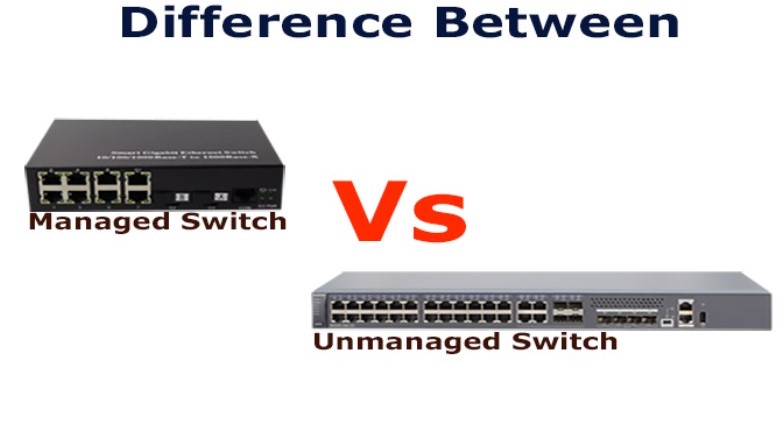Managed switches are superior to unmanaged ones in terms of functionality, but they necessitate the expertise of an administrator or engineer to fully realize their potential. More precise management of networks and their data frames is made possible by using a managed switch. On the other hand, unmanaged switches allow for the most fundamental kind of communication between devices on a network.
In this article, we will examine the differences between managed and unmanaged switches.
What is a managed switch?
Managed switches offer the same capabilities as unmanaged switches, with the extra benefit of management options.
More comprehensive network management, monitoring, and configuration options give you greater command over your home network’s data flow.
Thanks to the flexibility provided by managed switches, each port on the device can be adjusted individually to suit your needs. Benefits include a more precise means of keeping tabs on your network’s status and a wider range of options for tailoring its setup to your needs.
Typically, this switch model will have a web-based or command-line interface that allows for remote access to the device’s administrative interface. You can check in on the network or make adjustments without being in the same room as the switch itself.
Features of the fully controlled and monitored managed switch:
A wider variety of topologies, including Spanning Tree Protocol, Ring, Mesh, Stacking, and Aggregation, are available for its deployment, increasing its redundancy and reliability. Using remote management and software-defined networking (SDN) management, it is possible to monitor and analyze traffic data, control endpoint devices, and troubleshoot even the largest networks. Plenty of security features can control who is accessing the network, monitor attacks and help remediate any breaches that occur. Quality of Service (QoS) helps prioritize traffic and cluster similar devices together so that they can all make the most of the network’s resources.
What is an unmanaged switch?
The sole function of an unmanaged switch is to link Ethernet-enabled devices together in a network so that they can exchange data with one another. Some people see unmanaged switches as “the middle man.” While it effectively adds more ports to your network, it doesn’t accomplish much else and isn’t really noticeable.
Unmanaged switches can’t regulate network traffic, but they’re easy to deploy because they don’t require configuration. The only effort required is to plug it in. Unmanaged switches are frequently used in industrial settings to connect edge devices or temporarily add groups of devices to a larger network.
Unmanaged switches are always less expensive than their managed counterparts, however this is only because they lack the more advanced capabilities available in managed switches.
Unmanaged, low-cost basic connections include the following characteristics:
Automatic configuration and operation when plugged in. In only the simplest of network configurations, like star and daisy chain, will this work. The capacity to generate and store MAC-address tables improves traffic management over Ethernet hubs in a number of ways. There is no distinction between how switches treat multicast and broadcast traffic, which can lead to severe congestion issues known as broadcast storms.
Difference between Managed Vs Unmanaged switch:
The method used is the primary distinction between a managed and unmanaged switch. The managed switch gives command to network administrators, allowing them to prioritize LAN traffic and control its flow. Conversely, an unmanaged switch merely requires being plugged in and turned on. It enables the LAN’s devices to have private conversations with one another.
The network cannot be altered with an unmanaged switch, but it is simple to use. As a result, it is universally adopted by new businesses. However, a managed switch enables LAN administration, configuration, and monitoring. In addition, the managed switch’s redundancy facilitates data duplication and restoration in the event of a device or network failure.
One of the unmanaged switch’s basic security features is a lockable port cover, which prevents unauthorized access to the device. Managed switches, on the other hand, have more robust safety features. It can shut down activity threads, secure data, and manage plans all with its network monitoring and control abilities.
It’s no secret that unmanaged switches are less expensive than their managed counterparts. In addition, the cost varies based on the variety of ports available.
In most cases, an unmanaged switch is the best option for a small network, such as that of a home or small business. Businesses with a wide network footprint or that rely on a data center and could benefit from tighter control over network traffic should consider a managed switch.
Managed Vs Unmanaged switch and which one to buy?
There are a lot of things to consider when picking a managed switch. Talk to a qualified IT expert or network administrator. The following are some questions that are useful to consider when making a purchase in general.
such as switches are installed in which location? It’s important to know how many people and gadgets will be accessing the network simultaneously. Can network traffic be managed, and is network configuration required? In which reason you want use the switches?
It is common for networks with fewer than a dozen connected devices to use an unmanaged switch. Furthermore, there is no need for safety and management. Managed switches offer greater adaptability and functionality than their unmanaged counterparts. It sees widespread deployment in institutional contexts like hospitals, schools, and government agencies.






